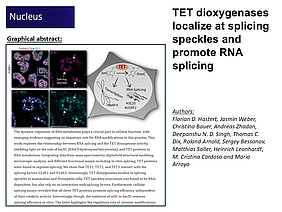New publication by the Cardoso lab on how TET dioxygenases localize at splicing speckles and promote RNA splicing
Hastert FD, Weber J, Bauer C, Zhadan A, Singh DND, Dix TC, Arnold R, Bessonov S, Soller M, Leonhardt H, Cardoso MC, Arroyo M (2025) TET dioxygenases localize at splicing speckles and promote RNA splicing. Nucleus, 16(1):2536902 Link
Abstract:
The dynamic regulation of RNA metabolism plays a crucial part in cellular function, with emerging evidence suggesting an important role for RNA modifications in this process. This study explores the relationship between RNA splicing and the TET dioxygenase activity, shedding light on the role of hm5C (RNA 5-hydroxymethylcytosine), and TET proteins in RNA metabolism. Integrating data from mass spectrometry, AlphaFold structural modeling, microscopic analysis, and different functional assays, including in vitro splicing, TET proteins were found to regulate splicing. We show that TET1, TET2, and TET3 interact with the splicing factors U2AF1 and U2AF2. Interestingly, TET dioxygenases localize in splicing speckles in mammalian and Drosophila cells. TET speckles association was found to be RNA-dependent, but also rely on its interaction with splicing factors. Furthermore, cellular splicing assays revealed that all three TET proteins promote splicing efficiency independent of their catalytic activity. Interestingly, though, the oxidation of m5C to hm5C restores splicing efficiency in vitro. The latter highlights the regulatory role of cytosine modifications in RNA metabolism. These findings provide insights into the complex interplay between RNA modifications and splicing, suggesting a multifaceted role for TET proteins in RNA metabolism beyond their canonical function in the oxidation of 5mC in DNA.
Read the full paper here: https://www.tandfonline.com/doi/full/10.1080/19491034.2025.2536902#abstract

